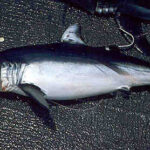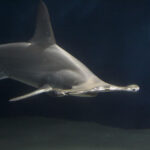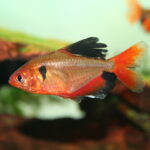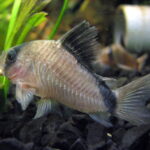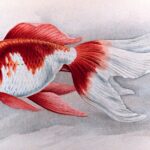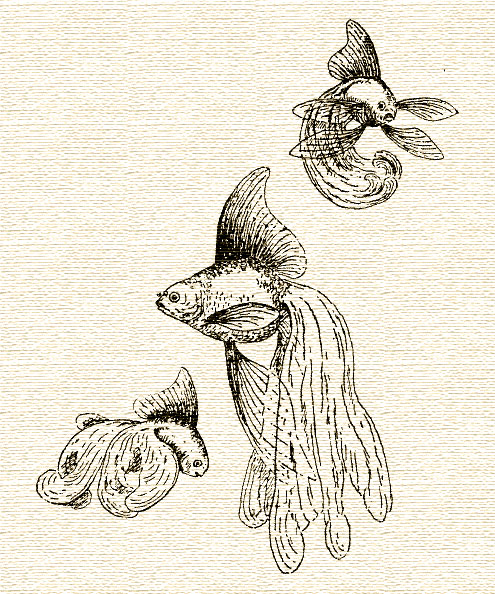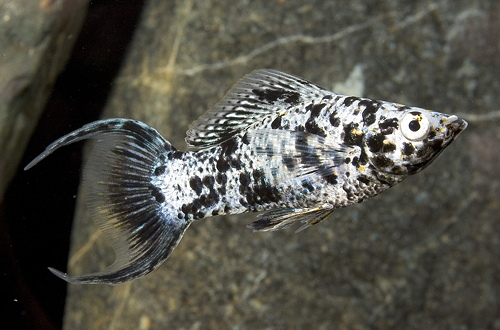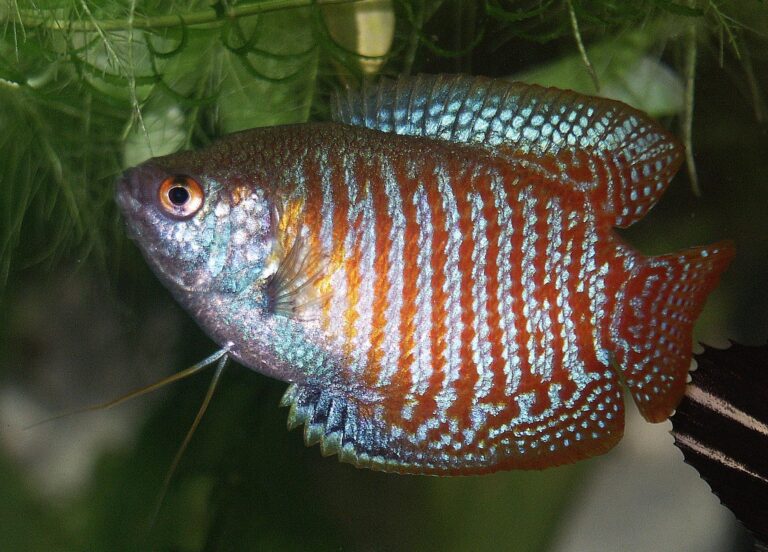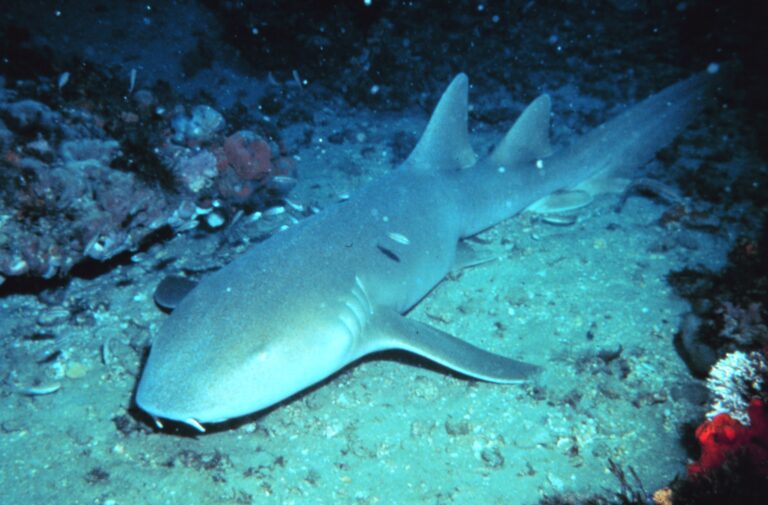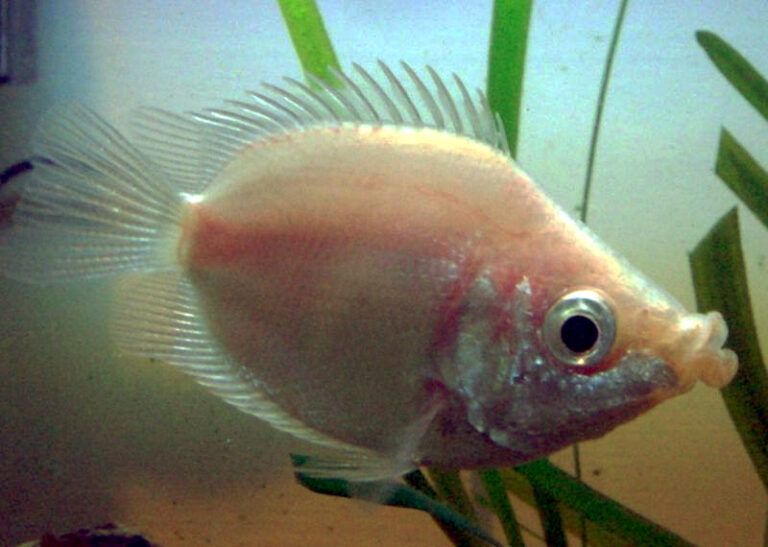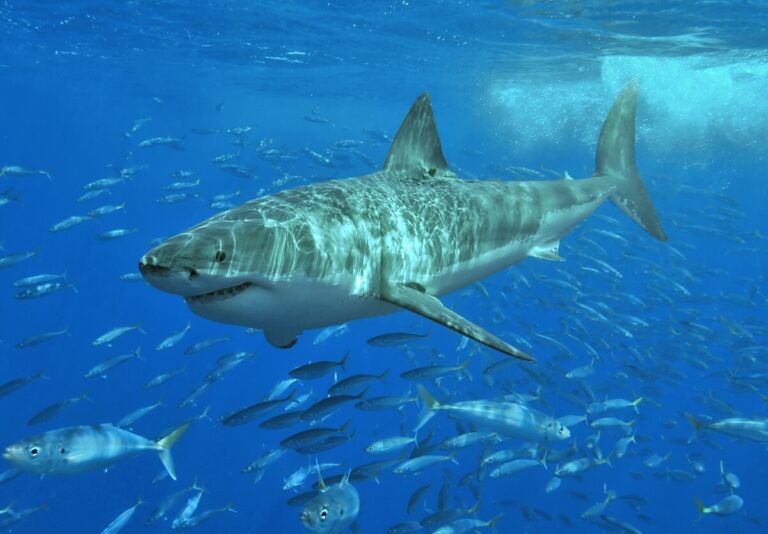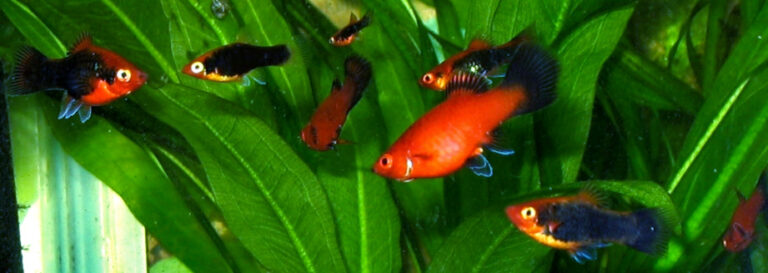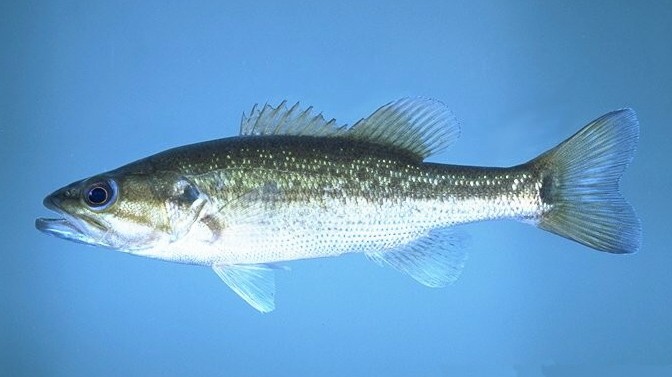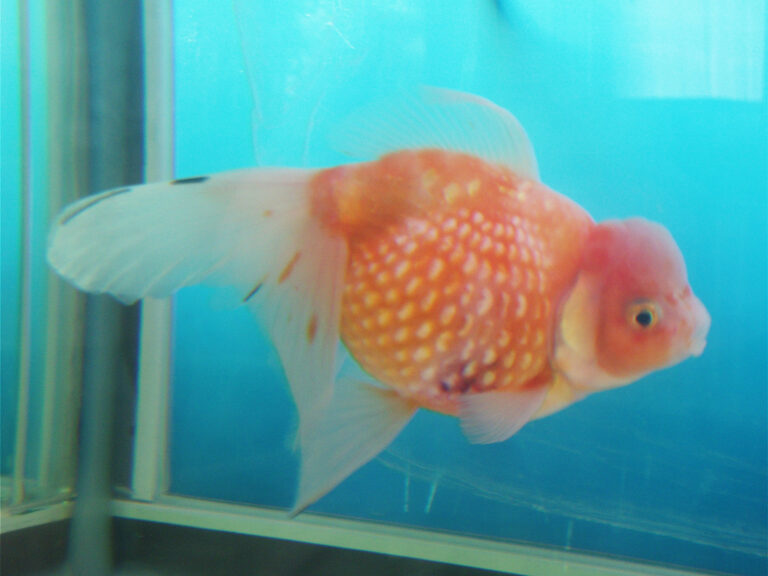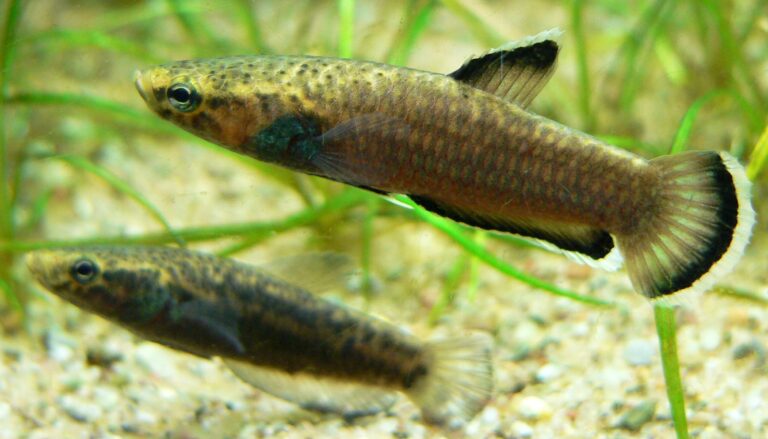Glass Catfish
By Ryan Maron | Last Modified: June 5, 2025
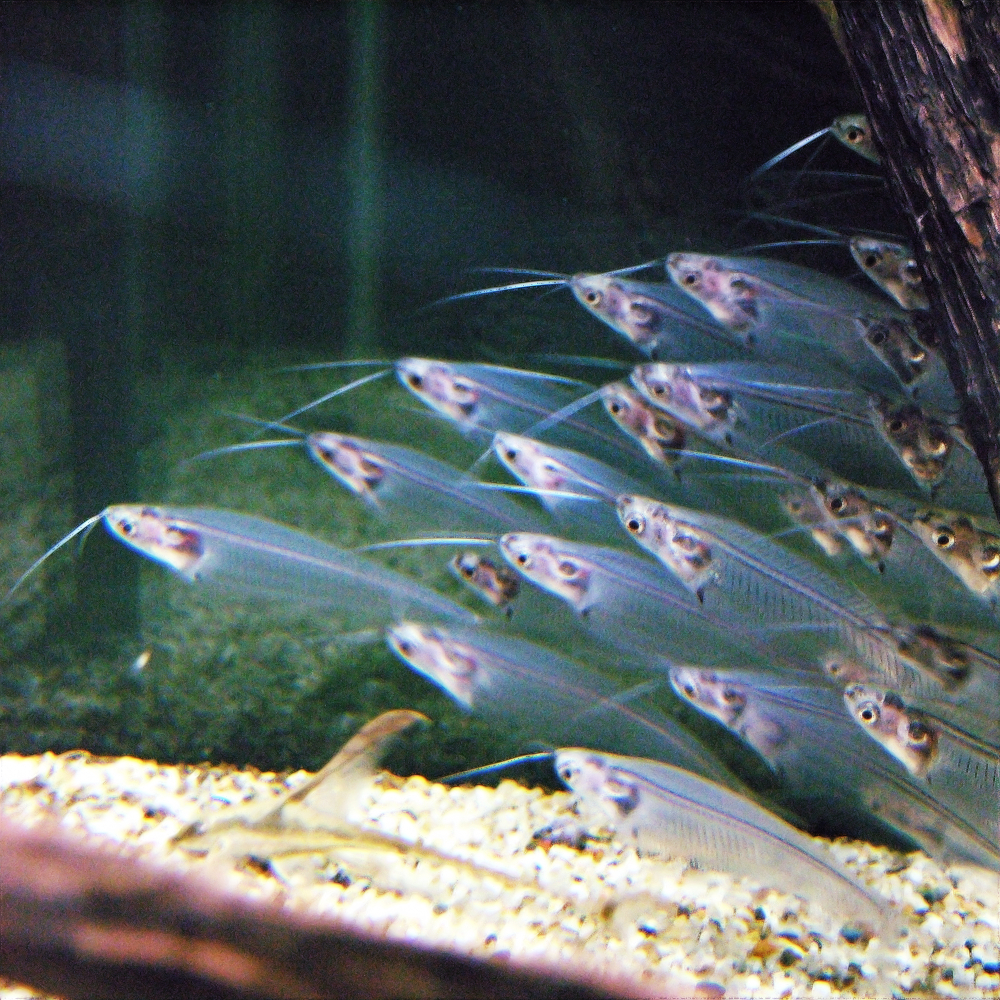
The Glass Catfish (Kryptopterus bicirrhis) stands as one of Southeast Asia’s most distinctive freshwater species, renowned for its remarkable transparency that renders internal organs and skeletal structure visible through translucent flesh. This ethereal appearance has captivated aquarists and ichthyologists alike, establishing the species as both a popular aquarium inhabitant and a subject of scientific fascination. Native to the river systems of Thailand, Cambodia, and Vietnam, the Glass Catfish plays a crucial ecological role as a mid-water predator, helping maintain the delicate balance of aquatic food webs in its native habitat.
The species demonstrates exceptional schooling behavior, forming large aggregations that move in synchronized patterns through the water column. These schools serve multiple functions within the ecosystem, from controlling populations of smaller fish and invertebrates to providing sustenance for larger predatory species. The Glass Catfish’s unique physiology and behavior patterns make it an indicator species for river health, as populations decline rapidly in response to pollution or habitat degradation.
| Feature | Details |
|---|---|
| Common Name | Glass Catfish |
| Scientific Name | Kryptopterus bicirrhis |
| Family | Siluridae |
| Typical Size | 15-20 cm (6-8 inches), 50-80 grams |
| Habitat | Large rivers and tributaries |
| Diet | Omnivorous planktivore |
| Distribution | Mekong Basin, Southeast Asia |
| Conservation Status | Least Concern |
Taxonomy & Classification
The Glass Catfish belongs to the family Siluridae, a diverse group of catfish species distributed across Asia and Africa. The genus Kryptopterus, derived from Greek words meaning “hidden fin,” encompasses approximately 20 species characterized by their elongated bodies and reduced dorsal fin structure. Kryptopterus bicirrhis was first scientifically described by Valenciennes in 1840, though taxonomic confusion persisted for decades due to misidentification with related species.
Recent molecular studies have refined the classification of Glass Catfish populations, revealing genetic variations between river systems that may represent distinct subspecies. The Mekong River population shows subtle genetic differences from specimens collected in the Chao Phraya and Mae Ping river systems, suggesting potential reproductive isolation over geological time scales. These findings have important implications for conservation efforts, as each population may require separate management strategies.
The species exhibits several primitive characteristics that link it to ancestral catfish lineages, including the retention of a swim bladder connected to the inner ear via Weberian ossicles. This anatomical feature enhances their ability to detect pressure changes and low-frequency sounds, crucial adaptations for life in turbid river environments. The Glass Catfish’s transparent tissue structure represents a unique evolutionary adaptation among freshwater catfish species, though the exact selective pressures that led to this trait remain subjects of ongoing research.
Physical Description
The Glass Catfish’s most striking feature is its remarkable transparency, which allows observers to see internal organs, the spine, and swim bladder through the body wall. This transparency results from the absence of guanine crystals in the skin and muscle tissue, compounds that typically create the opaque appearance in most fish species. The body maintains a silvery sheen along the lateral line and dorsal region, creating an ethereal, ghost-like appearance in the water.
Adult specimens typically reach lengths of 15-20 centimeters, with females generally growing larger than males. The body shape is elongated and laterally compressed, perfectly adapted for life in flowing water. The head is small and pointed, featuring a subterminal mouth equipped with numerous small teeth arranged in bands. Two prominent barbels extend from the upper jaw, serving as sensory organs for detecting food and navigating in murky water conditions.
The dorsal fin structure represents one of the most distinctive features of the Glass Catfish, consisting of a single ray followed by a tiny vestigial fin. The anal fin extends for approximately two-thirds of the body length, providing the primary means of propulsion through undulatory movements. The pectoral fins are well-developed and equipped with sharp, serrated spines that can be locked in an extended position for defense. The caudal fin displays a deeply forked shape, enhancing swimming efficiency in river currents.
Sexual dimorphism becomes apparent in mature individuals, with females developing a more rounded abdomen and slightly larger overall size. Males typically display more intense coloration along the barbels and may develop small tubercles on the pectoral fin spines during breeding season. The transparent body allows for easy observation of internal reproductive organs, making sex determination relatively straightforward in mature specimens.
Habitat & Distribution
The Glass Catfish inhabits the major river systems of Southeast Asia, with its primary distribution centered on the Mekong River basin spanning Thailand, Laos, Cambodia, and Vietnam. Significant populations also occur in the Chao Phraya River system in Thailand and the Mae Ping River, demonstrating the species’ adaptation to large, flowing water bodies. Historical records suggest a broader distribution that may have included parts of Myanmar and southern China, though current populations in these regions remain unconfirmed.
These fish prefer the main channels of large rivers and their major tributaries, typically inhabiting areas with moderate to strong currents and depths ranging from 5-30 meters. Water temperatures in their native habitat fluctuate between 22-28°C throughout the year, with seasonal variations corresponding to monsoon patterns. The species shows a preference for well-oxygenated water with pH levels between 6.0-7.5, conditions typical of the region’s major river systems.
Substrate preferences vary with life stage, with juvenile Glass Catfish often found over sandy or muddy bottoms near riverbanks, while adults typically occupy mid-water zones above deeper channels. The species demonstrates remarkable adaptability to seasonal flood cycles, moving between main channels and flooded forests during high water periods. During dry seasons, populations concentrate in deeper pools and main river channels where water levels remain stable.
Human activities have significantly impacted Glass Catfish habitat throughout their range. Dam construction on the Mekong River has altered natural flow patterns and blocked traditional migration routes, while agricultural runoff and industrial pollution have degraded water quality in many areas. Climate change has intensified these challenges, with altered precipitation patterns affecting the seasonal flood cycles crucial to the species’ life history. Similar habitat challenges are faced by other freshwater species, as detailed in comprehensive studies of river fishing techniques that emphasize the importance of understanding natural flow patterns.
Diet & Feeding Behavior
The Glass Catfish functions as an opportunistic planktivore, feeding primarily on zooplankton, small crustaceans, and aquatic insect larvae suspended in the water column. Their feeding strategy involves filtering small organisms from the water while swimming in coordinated schools, creating a dynamic feeding front that efficiently harvests available prey. The species exhibits diel feeding patterns, with peak activity occurring during dawn and dusk hours when planktonic prey concentrations are highest.
Juvenile Glass Catfish display different feeding preferences compared to adults, focusing heavily on microscopic organisms such as rotifers, copepod nauplii, and small cladocerans. As they mature, their diet expands to include larger zooplankton, aquatic worms, and occasional small fish. The transparent body structure allows researchers to observe stomach contents and feeding behavior in real-time, providing valuable insights into their ecological role within river ecosystems.
Seasonal variations in diet composition reflect changes in prey availability throughout the year. During flood seasons, terrestrial insects and organic matter become important food sources as rising waters inundate surrounding vegetation. The species demonstrates remarkable feeding flexibility, adjusting their behavior to exploit temporary food resources such as emerging aquatic insects during reproductive periods of various invertebrate species.
The Glass Catfish’s feeding behavior involves continuous swimming and filtering, requiring significant energy expenditure that is offset by the rich planktonic environment of their native rivers. Their barbels play a crucial role in detecting chemical gradients that indicate areas of high prey concentration, allowing schools to efficiently locate feeding opportunities. This feeding strategy positions them as important links in the aquatic food web, transferring energy from primary producers and small invertebrates to higher trophic levels.
Behavior & Adaptations
The Glass Catfish exhibits highly developed schooling behavior, forming aggregations that can number in the hundreds or thousands of individuals. These schools display remarkable coordination, moving as unified entities through the water column with synchronized turning and feeding movements. The schooling behavior serves multiple functions, including predator avoidance, enhanced feeding efficiency, and improved hydrodynamic performance in river currents.
Individual fish within schools maintain specific spacing and positioning relative to their neighbors, creating a dynamic three-dimensional structure that constantly shifts in response to environmental stimuli. The species demonstrates sophisticated communication through lateral line detection of water movements and pressure changes generated by neighboring fish. Visual cues also play a role in school coordination, with the transparent body structure allowing fish to perceive the movements of individuals throughout the group.
The Glass Catfish’s swimming behavior is characterized by continuous motion, rarely remaining stationary for extended periods. This perpetual movement pattern is an adaptation to their planktivorous feeding strategy and the flowing water environment they inhabit. The elongated anal fin provides efficient propulsion through undulatory movements, while the reduced dorsal fin structure minimizes drag during sustained swimming.
Stress responses in Glass Catfish include increased schooling density and altered swimming patterns, behaviors that can be observed in both wild and captive populations. The species shows remarkable sensitivity to water quality changes, with behavioral modifications often preceding measurable physiological stress indicators. These behavioral adaptations make the Glass Catfish an excellent indicator species for assessing ecosystem health in river environments.
Territorial behavior is minimal in this species, with aggressive interactions primarily limited to feeding competition during periods of resource scarcity. The schooling lifestyle largely eliminates the need for individual territory defense, though dominant individuals within schools may secure preferred feeding positions. This cooperative behavior contrasts sharply with many other catfish species that display more aggressive territorial tendencies.
Reproduction & Life Cycle
The Glass Catfish reaches sexual maturity at approximately 12-18 months of age, corresponding to a body length of 10-12 centimeters. Reproductive cycles are closely tied to seasonal flood patterns, with spawning typically occurring during the early stages of the wet season when water levels begin to rise. The species exhibits broadcast spawning behavior, releasing eggs and sperm into the water column where fertilization occurs externally.
Spawning aggregations form in specific areas of the river system, often near tributary confluences where water mixing creates optimal conditions for egg development. Males develop subtle breeding colors and may display increased territorial behavior during the reproductive season, though the schooling structure generally remains intact. Females can produce between 3,000-8,000 eggs per spawning event, with larger individuals typically producing more eggs.
The eggs are pelagic and semi-adhesive, drifting with river currents while developing over a period of 24-36 hours depending on water temperature. Newly hatched larvae measure approximately 3-4 millimeters in length and possess a large yolk sac that provides nutrition during the first few days of life. The transparent characteristics are not immediately apparent in larvae, developing gradually as the fish mature.
Juvenile development occurs in shallow, protected areas along riverbanks and in flooded vegetation where abundant food sources support rapid growth. Young Glass Catfish form small schools within weeks of hatching, gradually joining larger aggregations as they develop. Growth rates vary significantly based on food availability and environmental conditions, but juveniles typically reach 5-8 centimeters in length by their first winter.
The species demonstrates remarkable reproductive resilience, with multiple spawning events possible during extended wet seasons. This reproductive strategy helps ensure population stability despite high predation pressure on eggs and larvae. However, dam construction and altered flow regimes have disrupted traditional spawning areas and timing, presenting significant challenges for natural reproduction in many river systems.
Predators & Threats
Adult Glass Catfish face predation from a variety of larger fish species native to Southeast Asian river systems, including snakeheads, large cyprinids, and other catfish species. The transparent body structure, while unique, does not provide significant camouflage advantages in the open water habitats they typically occupy. Instead, the species relies primarily on schooling behavior and vigilance to avoid predation.
Juvenile Glass Catfish are particularly vulnerable to predation from a broader range of species, including smaller predatory fish, aquatic birds, and invertebrate predators. The early life stages experience extremely high mortality rates, with estimates suggesting that less than 1% of eggs successfully reach adulthood in natural conditions. This high mortality is offset by the species’ prolific reproductive output and multiple spawning events per year.
Human activities represent the most significant threat to Glass Catfish populations throughout their range. Overfishing has severely depleted wild populations, particularly due to collection for the international aquarium trade. Traditional fishing methods targeting the species include fine-mesh nets and fish traps that capture entire schools, often without regard for size or reproductive status.
Habitat degradation poses an equally serious threat to Glass Catfish populations. Dam construction on major rivers has altered natural flow patterns, blocked migration routes, and created barriers to genetic exchange between populations. The Mekong River system, which supports the largest Glass Catfish populations, has been particularly impacted by hydroelectric development projects that have fundamentally changed the river’s ecology.
Water pollution from agricultural runoff, industrial discharge, and urban development has degraded water quality throughout the species’ range. Glass Catfish are particularly sensitive to chemical pollutants and heavy metals, showing behavioral changes and reduced reproductive success in contaminated waters. Climate change has intensified these challenges by altering precipitation patterns and increasing the frequency of extreme weather events that can devastate local populations.
Invasive species introduction has created additional pressure on Glass Catfish populations through competition for food resources and habitat. Non-native fish species introduced for aquaculture have established breeding populations in several river systems, altering community structure and ecosystem dynamics. The complex challenges facing aquatic ecosystems require sophisticated management approaches, similar to those used in various types of fisheries management worldwide.
Conservation Status
The International Union for Conservation of Nature (IUCN) currently classifies the Glass Catfish as Least Concern, though this designation may not accurately reflect the species’ current conservation status. Population assessments are complicated by the wide distribution range and difficulty in conducting comprehensive surveys in remote river systems. However, regional studies suggest significant population declines in heavily impacted areas, particularly in the lower Mekong River basin.
Recent conservation efforts have focused on habitat protection and restoration, with several protected areas established along major river systems within the species’ range. The Mekong River Commission has developed guidelines for maintaining environmental flows that support Glass Catfish populations, though implementation remains inconsistent across different countries. Collaborative research programs between regional governments and international organizations have improved understanding of the species’ ecology and conservation needs.
Captive breeding programs have been established in several countries to reduce pressure on wild populations and support the aquarium trade. These programs have achieved varying degrees of success, with some facilities producing thousands of individuals annually for both commercial and conservation purposes. However, genetic diversity concerns have emerged as most breeding programs rely on small founder populations that may not represent the full genetic diversity of wild populations.
Enforcement of fishing regulations remains a significant challenge throughout the species’ range, with limited resources available for monitoring and enforcement activities. Community-based conservation initiatives have shown promise in some areas, with local fishing communities developing sustainable harvesting practices and participating in habitat restoration projects. Education programs targeting both local communities and international consumers have raised awareness about the conservation status of Glass Catfish populations.
The species’ future conservation depends largely on addressing the broader environmental challenges facing Southeast Asian river systems. Climate change adaptation strategies must consider the specific needs of Glass Catfish and other aquatic species that depend on natural flow regimes and seasonal flood cycles. International cooperation is essential for effective conservation, as the species’ range spans multiple countries with different conservation priorities and capabilities.
Human Interaction
The Glass Catfish has become one of the most popular freshwater aquarium species worldwide, prized for its unique transparent appearance and peaceful schooling behavior. The international aquarium trade represents a significant economic activity, with millions of individuals exported annually from Southeast Asian countries. This trade provides important income for local communities but has also contributed to population declines in some areas due to overexploitation.
Aquarium maintenance of Glass Catfish requires specific conditions that replicate their natural habitat, including well-oxygenated water, moderate currents, and appropriate schooling opportunities. The species’ sensitivity to water quality makes them excellent indicator species for aquarium health, though this same sensitivity can make them challenging for inexperienced aquarists. Proper care requires maintaining groups of at least six individuals in tanks of 200 liters or larger to accommodate their active swimming behavior.
Traditional fishing communities throughout Southeast Asia have harvested Glass Catfish for centuries as both a food source and for local trade. Traditional fishing methods typically involved sustainable practices that allowed populations to maintain stable numbers, but modern commercial fishing has intensified pressure on wild populations. The species’ schooling behavior makes them particularly vulnerable to efficient fishing techniques that can capture entire aggregations.
Scientific research on Glass Catfish has contributed significantly to understanding of fish physiology, behavior, and ecology. The transparent body structure has made the species valuable for studies of internal organ function, blood circulation, and nervous system activity. Research facilities worldwide maintain Glass Catfish colonies for various biological studies, contributing to broader scientific knowledge while reducing pressure on wild populations.
The species has cultural significance in several Southeast Asian countries, featured in traditional art, literature, and folklore. Local names for the Glass Catfish often reference their transparent appearance or ghost-like qualities, reflecting the fascination these fish have inspired throughout their native range. Conservation education programs have leveraged this cultural connection to promote awareness of the species’ conservation needs and the importance of protecting river ecosystems.
Recreational fishing for Glass Catfish is limited due to their small size and specialized habitat requirements, though they occasionally appear in catches targeting other species. The techniques required for successful capture of Glass Catfish are quite different from those used in basic fishing techniques, requiring specialized knowledge of their schooling behavior and habitat preferences.
Interesting Facts
The Glass Catfish’s transparency is so complete that researchers can observe heart beats, blood circulation, and digestive processes in living specimens without any invasive procedures. This unique characteristic has made them valuable research subjects for studies of fish physiology and has contributed to numerous scientific discoveries about vertebrate biology. The transparency results from the absence of light-reflecting crystals in the tissues, a trait that appears to be genetically controlled and may have evolved as a form of camouflage in their natural habitat.
Despite their common name, Glass Catfish are not the only transparent fish species, but they are among the most transparent vertebrates in the world. Their transparency is so remarkable that they can essentially become invisible when viewed from certain angles in their natural habitat. This optical illusion has led to numerous reports of “ghost fish” in Southeast Asian rivers, contributing to local folklore and mythology surrounding these remarkable creatures.
The species exhibits an unusual response to stress and death, with their normally transparent bodies becoming opaque white when subjected to extreme stress or upon death. This color change occurs within minutes and is thought to result from the contraction of chromatophores and changes in tissue structure. The phenomenon has practical implications for aquarium keeping, as healthy Glass Catfish should maintain their transparency under proper care conditions.
Glass Catfish possess an extraordinary ability to detect electrical fields generated by other organisms, a sense called electroreception that is uncommon among freshwater fish species. This ability helps them locate prey in murky water and may play a role in navigation and predator avoidance. The electrical sensitivity is so acute that Glass Catfish can detect the bioelectric fields generated by the gill movements of other fish from several meters away.
The species demonstrates remarkable longevity in captivity, with properly maintained individuals living 6-8 years or more. This longevity, combined with their peaceful nature and unique appearance, has made them popular among serious aquarists who maintain stable, long-term aquarium systems. Wild longevity is less well-documented but is believed to be similar to captive lifespans under optimal conditions.
Glass Catfish schools can span impressive distances, with some aggregations stretching over 100 meters in length along river channels. These massive schools create dynamic, flowing patterns that can be observed from considerable distances, particularly during feeding activities when the entire school moves in synchronized waves through the water column. The social structure within these large schools is complex, with individual fish maintaining specific positions and roles within the group hierarchy.
Frequently Asked Questions
How do Glass Catfish maintain their transparency?
Glass Catfish maintain their transparency through a unique combination of anatomical adaptations, including the absence of guanine crystals in their skin and muscle tissue, reduced pigmentation, and specialized tissue structure that allows light to pass through without significant scattering. This transparency is maintained throughout their lives, though it can be temporarily lost during periods of extreme stress or illness.
Can Glass Catfish survive in aquariums without schooling companions?
Glass Catfish cannot thrive in isolation and require the company of their own species to maintain proper health and behavior. Solitary individuals often exhibit stress-related behaviors, reduced feeding, and increased susceptibility to disease. Aquarium maintenance should include groups of at least six individuals, with larger groups providing better psychological and social benefits for the fish.
What is the primary difference between wild and captive-bred Glass Catfish?
Wild-caught Glass Catfish typically display more robust schooling behavior and slightly larger adult sizes compared to captive-bred individuals. However, captive-bred fish often adapt better to aquarium conditions and show reduced stress responses to handling and environmental changes. Genetic diversity may be limited in captive-bred populations, though this rarely affects individual fish health or appearance.
How sensitive are Glass Catfish to water quality changes?
Glass Catfish are extremely sensitive to water quality changes, particularly fluctuations in temperature, pH, and dissolved oxygen levels. They serve as excellent indicator species for aquarium health, often showing behavioral changes before water quality issues become apparent through testing. Sudden changes in water parameters can cause stress responses visible through altered swimming patterns and reduced transparency.
Conclusion
The Glass Catfish represents a remarkable example of evolutionary adaptation and ecological specialization within Southeast Asian river systems. Their unique transparency, sophisticated schooling behavior, and critical role as planktivorous predators make them essential components of aquatic ecosystems throughout their range. As human activities continue to impact river systems across Southeast Asia, the conservation of Glass Catfish populations serves as an indicator for the overall health of these vital freshwater ecosystems, emphasizing the importance of sustainable management practices and international cooperation in preserving aquatic biodiversity for future generations.
Share The Article:
More Fish Species:
-
Veiltail Goldfish
The Veiltail Goldfish stands as one of the most distinctive and graceful varieties within the goldfish family, renowned for…
-
Lyretail Molly
The Lyretail Molly (*Poecilia latipinna*) stands as one of the most recognizable and ecologically significant freshwater fish species in…
-
Gouramis
Gouramis represent one of the most fascinating and diverse groups of freshwater fish, belonging to the family Osphronemidae within…
-
Nurse Shark
The Nurse Shark (Ginglymostoma cirratum) stands as one of the most recognizable and ecologically significant bottom-dwelling sharks in tropical…
-
Kissing Gourami
The Kissing Gourami (*Helostoma temminckii*) stands as one of the most distinctive and recognizable freshwater fish species in both…
-
Jaguar Cichlid
The Jaguar Cichlid stands as one of Central America’s most formidable predatory fish, renowned for its impressive size, aggressive…
Discover
-
Winter Fishing Tips: 7 Cold-Weather Tactics Successful Anglers Use
Most anglers pack away their gear when the temperature drops, but the dedicated few know something the others don’t:…
-
Great White Shark
The Great White Shark (*Carcharodon carcharias*) stands as one of the ocean’s most formidable apex predators, commanding respect and…
-
Michigan Fishing License 2025: Complete Cost & Requirements Guide
Ask any angler about the most frustrating part of fishing, and paperwork will likely rank right up there with…
-
Fly Fishing in the UK: Top Rivers and Seasonal Patterns
After nearly three decades casting flies across waters from Michigan to Maine – and now spending several weeks each…
-
How to Fish for Bluegill: 2025 Complete Guide
Bluegill might not be the biggest fish in the pond, but they sure make up for it in fight…
-
Best Fishing Spots in California: Lakes, Rivers, and Coastal Hotspots
California fishing has always struck me as a study in beautiful contradictions. From snow-fed alpine lakes to sweltering desert…
Discover
-
Southern Platyfish
The Southern Platyfish, scientifically known as *Xiphophorus maculatus*, represents one of the most significant freshwater fish species in both…
-
Tuxedo Platy
The Tuxedo Platy (Xiphophorus maculatus) stands as one of the most recognizable and beloved freshwater aquarium fish species, distinguished…
-
Spotted Bass
The Spotted Bass (Micropterus punctulatus) stands as one of North America’s most distinctive freshwater game fish, renowned for its…
-
Green Terror Cichlid
The Green Terror Cichlid stands as one of South America’s most formidable and visually striking freshwater fish species, commanding…
-
Pearlscale Goldfish
The Pearlscale Goldfish represents one of the most distinctive and captivating varieties of ornamental carp, distinguished by its characteristic…
-
Betta Fish
The Betta Fish, scientifically known as Betta splendens, is one of the most visually captivating and widely recognized freshwater…

